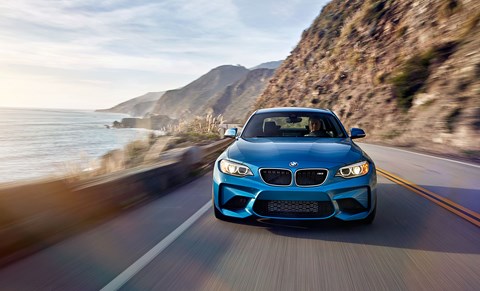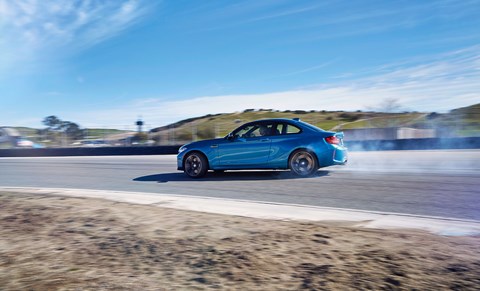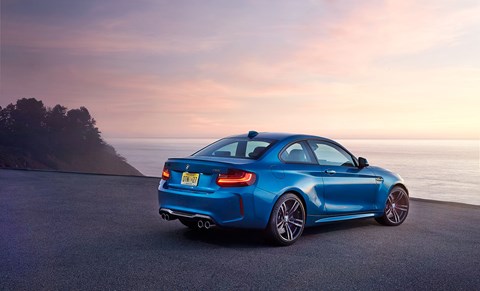► We drive the all-new 2016 BMW M2
► 365bhp, 343lb ft; 0-62mph in 4.5sec
► Numerous similarities to the E46 M3
Laguna Seca is a little bit of everywhere made awesome, its epic climbs and tortuous turns exaggerated versions of special roads from all over the world. The gut-wrenching Corkscrew mimics the technical, testing drop from Upper Finton to Lower Finton deep in England’s leafy B-road boondocks.
The long, engine-stretching start-finish ‘straight’ could be any stretch of flat-out autobahn. The blind approach to the Andretti hairpin is reminiscent of any number of unsighted braking zones in North Wales, and if the ultra-fast double left-hander onto the Rahal straight isn’t lifted whole from the Route Napoleon, Castellane to Grasse, I’ll eat my shoes.
So while the BMW M2 and I meet on a circuit, already I get the feeling M Division’s 365bhp, six-cylinder coupe will be just fine on the road. Earlier, on our first few reconnaissance laps, leaving the stability control untouched ensured the car stayed on a short leash, one that – given the sense of control the car oozes – more adventurous souls will soon want to lose.

Now, with the DSC off, the M2 is so responsive and yet so benign that those early DSC-on laps feel like wasted time. Liberated of its safety systems the M2 can’t wait to explore limits, leave rubber scars on every kerb and roast its Michelins until stick becomes slow-motion slip, the tail ever ready to give and receive lessons in Technicolor (sic) throttle-steer.
The really great news? The BMW’s lean-on-me front end. That broad front track – flared bodywork 55mm wider than the standard 2-series shell stretched over M4 forged aluminium suspension – is a key component of the M2’s corner-entry brilliance, bringing extra stability and consistently sharp turn-in whatever your entry speed. The car’s eagerness to change direction is intoxicating, particularly running into the kind of fast third- and fourth-gear corners in which the idea of scrubbing helplessly wide doesn’t bear thinking about.
And then there’s the steering. When electrically assisted power steering was still in its infancy we wailed and wept as each hydraulic rack was killed off. Mourn no longer. By holding back on the artificial-feeling speed-related trickery and embracing the kind of transparent simplicity that very helpfully just lets you know where you stand, the good times are back.
On its Sport setting the M2’s speed-sensitive M Servotronic helm is unobtrusive and the critical transition from the unassisted straight-ahead to any degree of lock imperceptibly smooth. And while the steering firms up ever so slightly to help maintain a chosen angle, it refrains from enhancing or diminishing the effort involved. The net results are quick reflexes and unambiguous feedback. Memory may be a fickle thing but for me the M2’s steering is a match for the E46 M3’s clarity and fluency.

Fine steering and a front end you can trust to the ends of the Earth? This is looking promising. Pushing harder at Laguna,the M2’s essential predictability remains intact. We carve through slow twists, arc down winding descents and cut hard uphill with balance, poise and effervescent enthusiasm. Unlike the 1M Coupe, which had to be wrestled hard from apex to apex, and unlike the brusque, impatient M4, the accessible M2 wants above all else to please and to entertain.
It has fewer rough edges than those two M cars, its limit a far broader, more welcoming boundary. Its responses may be fractionally less emphatic but they’re more linear and less tricky, its angle of attack only twisting elegantly into oversteer when you explicitly request it. Do so and the M2 responds eagerly, a quick flick of the wheel setting the car up, a shot of torque bringing the rear axle into play and that’s it, you’re there: quick hands and a sensitive foot holding the car in a picture-book drift for one, two, three seconds at a time. For the broadest grin, open the steering early and use the power to stretch a subtle slide to the very exit of the bend like warm bubblegum.
Visually and conceptually, the M2 is a continuation of the bloodline that binds 2002 Turbo and the 1M Coupe: pumped-up compact saloons with the tight dimensions to drive back-roads like they’re wide open circuits. Like those cars the M2 embellishes its donor shell with just enough visual menace to turn heads; swollen but shapely arches, re-styled black wheels with polished double spokes, a lipped bootlid framed by LED taillights, trademark M fins in both front wings, an evil-looking sculptured front bumper with three gaping intakes, taut side-skirts and a unique rear bumper bristling with chromed tailpipes.

Like those older BMW performance icons, the M2 also keeps things relatively simple, pursuing an admirable and unfashionable one-spec-fits-all approach. To keep costs down and minimise complexity, nice-to-have options such as adaptive suspension, carbon-ceramic brakes, a competition pack and an array of three different settings each for steering, dampers and throttle response are conspicuous by their absence.
Instead the M2 relies on non-adjustable springs and shocks (remember those?), a standard-issue BMW drive mode selector (choose from Comfort, Sport and Sport+ to ramp up the steering and shift mapping via the DCT gearbox if fitted; no adaptive dampers remember) and a handy M Dynamic Mode (MDM) within the stability control hierarchy that fuses a more liberal stability control with a differential setting hellbent on power oversteer.
Context? At 1570kg (with driver) the M2 is 25% lighter than the M4. On price it competes with the Audi RS3 and AMG A45 in that big-money stratosphere far above performance car bargains such as the Focus RS, V8 Mustang and Honda Civic Type R. To an extent it justifies the premium over those cars and the excellent M235i by incorporating a number of essential M4 elements.
And while the M235i can be had in convertible guise, the M2 is a fixed-head wide-body two-plus-not-much coupe with (expensive) lightweight suspension and the M4’s (expensive) active diff. There are only four colours to choose from. Options are limited to the seven-speed dual-clutch gearbox (DCT) instead of the manual six-speeder and a tight selection of safety, comfort and convenience items. A head-up display, those adjustable dampers, a carbonfibre roof and LED headlamps are all missing from the options list.
Inside it takes a second look to appreciate the M2 difference. M logos run amok, contrasting blue abounds and though the instrument faces have been restyled, they’re now harder to read. Dash ornamentation is by open-pore carbon accents, but the dominating materials are again black composites, black fabric and black leather. Functional? Yes. Seductively premium? Less so.

Like the 1M Coupe and the M4, the M2 uses a turbocharged 3.0-litre straight-six. The M2’s unit is rated at 365bhp and 343lb ft (plus another 26lb ft with 20 seconds of available overboost) – 60bhp and 63lb ft down on the M3/M4’s. While the days of the naturally aspirated BMW petrol six are long gone, not all of Munich’s turbocharged engines are genetically related.
Although the M2 motor uses the M4’s pistons, liners, big-end bearings, oil pump and sump, it is not a bespoke M-division powerplant but an upgraded M235i motor. Despite the TwinPower nomenclature, boost pressure is provided by a single twin-scroll turbo. BMW quotes a combined 35.8mpg – feasible certainly, though enjoying the car managed to empty its 52-litre tank in less than 190 miles.
Finally let loose on Californian byways we’re by turns leading and chasing an M4. It never gets away, the M2 neutralising the bigger car’s engine advantage with its lighter weight and greater agility. The numbers tell the story. Against the stopwatch the manual M4 is only two-tenths of a second quicker to 62mph (4.3sec versus 4.5sec; 4.1sec and 4.3sec for the DCT versions).
The performance gap narrows further with in-gear acceleration – from 50mph to 75mph in fourth gear there’s only a tenth in it, a claimed 3.5sec versus the 3.6sec for the M2. Both are pegged at 155mph unless you opt for the M Driver’s package, which will let them run on to 168mph and 175mph respectively.
Redlined at 7000rpm, the M2 engine is the best of both worlds: willing to rev, it also has grunt enough to spin the rear wheels in second gear in the dry. Sounds good too: loud, sonorous, dense. With speed the low-rev hum builds through a roar to barely-legal thunder just before each shift, punched through with the commendably quick and slick manual ’box on this test car.
The DCT unit changes ratios even more swiftly of course, and offers launch control, a smokey burnout function, six different drive modes and creep on demand for getting in and out of tight spaces. A wise choice for tedious commutes perhaps but dispensable for serious Sunday mornings.

The M2’s on-track brilliance translates almost wholesale to the road, where its mix of no-frills hardware and relatively simple software breeds easy, laugh-out-loud speed. It is better tied down than the M235i with stricter body control and sharper responses. Yet despite these dynamic strengths there is enough compliance built into the chassis and the made-to-measure Michelin Pilot Sport tyres to absorb potholes, yawning cracks, impromptu camber variations, split-mu ambushes and washboard corrugations.
From this compliance floods confidence and a sense of control. The M2 sweetly smoothes the way ahead, keeping the lines of communication free of disturbances and harshness. At 245/35 ZR 19 up frontand 265/35 ZR 19 at the back the Michelins are as wide as the flared arches permit, but they’re not as broad as the M4’s gumballs.
The M2 may cede a little peak g as a result but in real life the difference matters not a jot, and the narrower rubber helps the M2 maintain a decent ride comfort on all but the very worst roads. The front end in particular is brilliant at soaking up serious topography without rocking the seat or steering wheel. The rear end, fat and squat, is less tolerant, and its patience is easily eroded by loading the rear wheels with torque on slippery or broken terrain.
The more brittle M4 set-up is known to require DSC assistance even at 150mph on a bumpy motorway. The 1M Coupe was even rougher and cruder, and so unsettled and twitchy at high speed that M Division decided to retrofit a stabilising aero kit on request. The M2 is a more benign animal, and more slippery: it undercuts the drag resistance of the base 2-series coupe by 5% to 0.35 while reducing lift by 35%.
Of more significance is the both sure-footed and relaxed aerodynamic balance. Lift off in the middle of a 100mph bend at nine-tenths? No problem. A quick lane-change with crosswinds on deeply-grooved concrete? Easy. An emergency stop from speed, plus an evasive swerve? No drama. The absolute deceleration is sufficiently urgent, and that hair-raising rear-to-front weight transfer that threatened to kick the 1M Coupe into the middle of next week has all but disappeared.

The M2 uses the M4’s big, drilled and inner-ventilated M Compound discs – 380mm at the front, 370mm in the rear – and its fat, metallic-blue, four-piston calipers. Track pads are an option (grabbier; a bit more noisy). It’s a fine set-up, virtually immune to fade, that bites at the first stab and captures all the energy your right foot can summon. The stopping power from 80mph is little short of phenomenal. Late braking becomes habitual, and when you’re running out of road it’s always the tyres that let up first, not the pads or discs.
Burbling back to base, wired, it’s clear that the M2 is almost embarrassingly talented, as adept on track as it is thrilling on the road. True, the rear seats are a leather-clad token gesture, the short wheelbase brings more than a shiver of excitement and, after a long day’s hard driving the insatiable devil inside is lusting for much more than 365bhp. But in terms of value for money, drift readiness and sheer driving joy, the M2 is a triumph.
Frank van Meel, BMW M division boss, has watched over the M2’s development since he joined the group over a year ago. ‘I like this car for its simplicity, straightforwardness, honesty and accessibility,’ he tells me. ‘It may be low on exotic options but it’s high on driving pleasure.
That said I don’t see the M2 challenging the M4. The M4 is more spacious and more prestigious, with a much wider range of bespoke specifications, including competition kit, GTS pack or convertible.’ Indeed while the M4 feels like a slimmer and more compact M6, the M2 is eerily close in ability and emotion to the coveted M3 E46.
According to BMW there is no limit to the M2’s production run. Odd then that several suppliers claim the total sales target to be a mere 16,000 units over less than three years… ‘If demand justifies it, we can increase capacity,’ says van Meel. Word is an M2 CS is already under development – rawer, leaner, over 400bhp – but in truth the wait for the next truly great M car is already over.

Why the M2 is (and isn’t) the E46 M3 reincarnated
The same…
Character: From the clarity and fluency of the steering to the awesome blend of easy-going compliance and on-limit gymnastics, the E46 M3 is very much the M2’s spiritual predecessor. More so even than the spikey, demanding 1M Coupe.
Size: Expecting the M2 to be a significantly smaller car than the E46 M3? Think again – the M3 is 24mm longer, but the M2 is wider (by 74mm!) and taller (by 27mm). And they have the exact same 1570kg official kerbweight.
Design: According to BMW design chief Karim Habib, the M2’s look will influence a whole new generation of M-cars. But the basic formula is the same as the E46 M3: ultra aggressive on the outside, muted and low key on the inside.
But different…
Engine: They’re both inline sixes, but while the E46 M3’s naturally aspirated 338bhp 3.2 screams to 8000rpm, the M2’s 3.0-litre deploys a twin-scroll turbo to achieve 365bhp and compensates for calling time 1000rpm earlier with a far fatter wodge of torque.
Brakes: From the ’Ring to Cadwell Park, the E46 M3 is a popular track hack – swiftly convincing owners to upgrade its single-piston brakes. The M2 gets the M4’s M compound discs and four-piston front/two-piston rear set-up from the factory.
Drivetrain: Both have a paddleshift auto option over a standard six-speed manual. But where the SMG II in the E46 was clunky, the M-DCT in the M2 is a weapon. Its active M diff out-plays M3’s variable LSD, too.
The specs: BMW M2
Price: £44,070
Engine: 2979cc 24v turbo straight-six, 365bhp @ 6500rpm, 343lb ft @ 1400-5560rpm, plus 26lb ft overboost from 1450-4750rpm
Transmission: Six-speed manual, electronically controlled active M differential, rear-wheel drive
Suspension: MacPherson strut front; multi-link rear
Performance: 4.5sec (4.3sec with DCT) 0-62mph, 155mph, 35.8mpg, 185g/km CO2
Weight: 1570kg (1645kg DCT)
On sale: April 2016
Read more from the March 2016 issue of CAR magazine